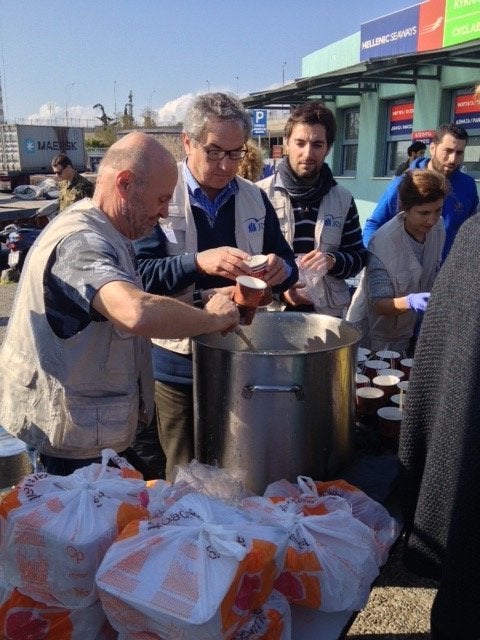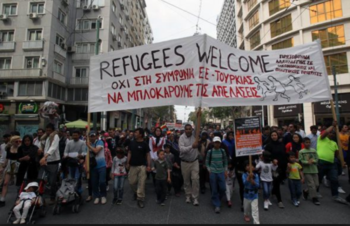The Refugee Solidarity Movement was created through the coming together of No Border Network activists and the Refugee Solidarity activists in the wake of the Refugee Crisis that Europe is currently grappling with. The main goal of the Refugee Solidarity movement is to build partnership and support for vulnerable refugees fleeing persecution and escaping to Europe from Africa and other regions. The movement gained particular attention with the current European Refugee crisis that has brought over a million economic and political refugees to Europe’s borders. Refugee Solidarity activists were particularly inspired to act after the horrendous treatment and conditions that Refugees found themselves in across Europe after the closing of borders and building of fences to limit their movement. This fostered collaboration between Refugee Solidarity activists and No Border activists as unification would strengthen their mission to help refugees. No Border activists shared many of the same goals and objectives as Solidarity activists and wanted to support the free movement of people across European borders and into European borders, by resisting migration control efforts. The combination of these two distinct yet similar groups, culminated in the establishment of a strengthened solidarity movement that aimed to provide support to refugee while also aiming to destroy the migration controls that limit refugee movement.
The goals of the Refugee Solidarity network are a combination of the aims that Refugee Solidarity activists and No Border Network activists have proposed within their separate movements but have forged together because many of them are similar and their is increased strength and power in the combination of their movements. The goals of the No Border Network are necessarily an extension of the ones proposed by the Refugee Solidarity movement where not only do they want European countries and governments to take in more refugees and improve the services available to refugees that guarantee their dignity and respect within the migration process but also leave European borders open so refugees are not trapped at various borders across Europe and have the ability to freely move and are not kept as trapped individuals who are facing ongoing persecution and displacement.
One of the main goals of the movements is to resist arbitrary migration controls into and across Europe. This includes the destruction of the numerous border fences in Greece, Macedonia, Slovenia, Hungary, Austria, Melilla, Ceuta and Slovakia that have sprung up during the European Refugee Crisis, it also includes demilitarization of the borders between Africa and Europe as forced migrants flee north. European countries have reinstated border control mechanisms as a form of preventing refugees from entering further into Europe, not only trapping a large amount of refugees in first destination countries such as Italy and Greece but also not allowing refugees to freely travel to more welcoming countries such as Sweden and Germany where many of their previous family members have already settled. This goal is truly to reinstate the shared common European spirit that firstly allowed the free migration of citizens across borders but now to extend that privilege to all refugees and showcase a common European spirit in the face of adversity.

Another goal of the movement is to create Solidarity networks for Refugees to have access to across Europe and Africa. These networks of Solidarity would include cooperation between different organizations across Europe and Africa, all with the shared goal of creating structures to help refugees in their journey to their final destination and provide them with support services ranging from legal help to language classes to overall improvement of the integration process of refugees into European society. Solidarity is one of the core missions of the movement and numerous refugee groups across Europe have formed partnership to build bridges across different groups of activists and aim to help refugees across the European continent. The solidarity movement does not solely focus on the physical construction of support services for refugees and structures made to help them, rather it is also build critical support networks across Europe that Refugees can tap into and ensure that they are safe when they continue on their migration journey across Europe.
A goal of the Refugee Solidarity Network is also to provide refugees with immediate services once they arrive on European shores and replace larger NGOs and governments who have been unable to and in some cases unwilling to provide important services to refugees. Also, offering individuals who are in Africa with professional services and opportunity to cross borders or establish a place in the local community. Cases of Solidarity activists providing key services to refugees include establishing alternative forms of service provision including the No Border Kitchen and the No Border Classroom which aim to provide refugees with essential services that are under provided by governmental agencies. Furthermore, solidarity activists aim to encourage ordinary citizens across Europe to host, feed and support refugees in their journeys across Europe. This has created a network of ordinary citizens from Greece to France who provide essential services to refugees under the banner of solidarity and actively try to help refugees in any way they can. Not only is the goal of this movement to provide refugees with essential services that they need but it is also to inspire a culture of solidarity among European citizens to aid and assist refugees in any way they can.


